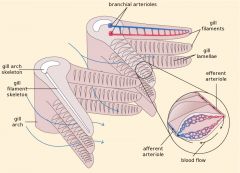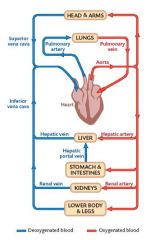![]()
![]()
![]()
Use LEFT and RIGHT arrow keys to navigate between flashcards;
Use UP and DOWN arrow keys to flip the card;
H to show hint;
A reads text to speech;
52 Cards in this Set
- Front
- Back
|
What are examples of things that need to be interchanged between an organism and its environment? |
respiratory gases (oxygen + co2) nutrients (glucose, fatty acids, amino acids, vitamins) excretory products (urea + co2) heat |
|
|
How in ratios in exchange maximised? |
Organisms must have larger surface area: volume ratio for more efficient exchange |
|
|
What can simple diffusion for exchange only be effective in relatively small organisms? |
As organism gets larger, volume increases more rapidly than surface area. Ratio is too close to maintain a steep enough diffusion gradient. Diffusion would take too long! |
|
|
How have organisms evolved to deal with exchange difficulties? |
1) Flattened shape so no cell is too far from surface 2) specialised gas exchange systems with large surface area: volume ratios. e.g. lungs in humans, gills in fish |
|
|
To revise, what are features of specialised gas exchange systems? |
1) Large surface area: volume ratio 2) Very thin for short diffusion pathway 3) Partially permeable 4) Movement of internal and external mediums |
|
|
What is the equation for diffusion (and how its maximised)?
p.s. this is flicks law (so s.a.c.d) |

|
|
|
Why are specialised exchange systems inside the organism? |
They are very thin so need to be protected |
|
|
How are gases exchanged in single-celled organisms? |
Through simple diffusion, through the cell-surface membrane exterior (instead of a permeable cell wall) |
|
|
How do insects conserve water? |
Have waterproof exoskeleton which is covered with a waterproof cuticle
They have a small surface area: volume ratio
|
|
|
Why is the insects small surface area: volume ratio an issue? |
This water conservation technique conflicts with need to facilitate simple diffusion. Cannot use body surface to diffuse gases like single-celled organisms |
|
|
What are insects internal tubes called? |
Trachea and tracheoles |
|
|
How are the trachea and tracheoles strengthened? |
Supported by strengthened rings of chitin |
|
|
How do respiratory gases move in + out of insects tracheal system? |
Along a diffusion gradient (co2 produced by insect cells and water from oxygen from outside flow in opposite directions to maintain diffusion gradient)
Ventilation (muscles move to create mass movements of air) |
|
|
What are the tiny insect pores called? |
spiracles |
|
|
How are the spiracles controlled? |
In some insects, valves open them to let water evaporate from insect. Then close them to conserve water loss |
|
|
What is the limitation of insect gas exchange? |
For simple diffusion to work, diffusion pathway needs to be short so insects need to be kept small |
|
|
Explain the structure of the gills? |

Gills are made up of gill filaments (held on gill bars) which are stacked in a pile. Within filaments are lamellae which increase surface area. Water is taken in through mouth, forced over gills, out through operculum. Uses counter current flow! |
|
|
Explain why the counter current principle is useful |
Blood and water flow in opposite directions over lamallae. Water has maximum oxygen concentration, about 80% diffuses into blood flowing opposite direction to it. This maintains a difference in oxygen concentrauib and diffusion gradient over whole length of lamallea |
|
|
Why do single-celled organisms not need very fast gas exchange rate? |
Have relatively low metabolic rates |
|
|
In insects, how do actively respiring cells get oxygen faster e.g. while flying? |
When resting, water diffuses out of cells into ends of trachea so oxygen diffuses slower to reach cells
When flying cells produce lactic acid which lowers water potential, water moves by osmosis into muscle cells -> faster diffusion |
|
|
How is fish ventilation unlike human ventilation? |
It is one way rather than tidal. Water enters through mouth, passes over filaments and lamallae and then out the operculum Water is denser, more viscous than air so it would take too much energy to cnage its momentum every breath |
|
|
What happens during fish inspiration? |
Mouth opens, mouth floor lowers to increase buccal cavity/mouth volume. Decreases mouth pressure, opercular valves close and water rushes in |
|
|
What happens during fish exspiration? |
Mouth closes, mouth contracts raising mouth floor. Decreases buccal cavity volume, and increases pressure. Pressure forces opercula valves open, water flows out over gills and out through operculum |
|
|
How are the diffusion gradients in and out of plant leafs maintained? |
Mitochondria carry out respiration and chloroplasts carry out photosynthesis |
|
|
How are leaves adapted for rapid diffusion? |
thin, flat shape -> large surface area many stomata (small pores) in lowere epidermis lots of interconnecting air-soaces throughout mesophyll |
|
|
How do leaves prevent excessive water loss while stull allowing for gas exchange? |
Guard cells surrounding stomata can open and close them on demand |
|
|
Why can mammals not have their surface (e.g. skin) as their gas exchange surface? |
As the animals get larger, ther surface area: volume ratio decreases too! |
|
|
What 2 factors affect whether an organism needs a specialised transport medium or a pump system? |
surface area: volume ratio how active organism is |
|
|
Why do mammals need a double circulatory system? |
pass through heart twice to increase blood pressure (if it didn't, pressure too low and circulation very slow) |
|
|
Describe the mammalian circulatory system |

memorise!!! |
|
|
Where do the renal arteries/veins go to/from? |
The kidney |
|
|
Where do the hepatic arteries/veins go to/from? |
The liver |
|
|
Where does the hepatic portal vein go to? |
From the stomach and intestines to the liver |
|
|
arteries |
blood away from heart to arterioles |
|
|
arterioles |
smaller arteries that take blood from arteries to capillaries |
|
|
capillaries |
tiny vessels that link arterioles to veins |
|
|
veins |
carry blood from capillaries back to heart |
|
|
What is the function of a tough outer layer? |
resists pressure changes |
|
|
What is the function of a muscle layer? |
can contract to control blood flow |
|
|
What is the function of a elastic layer? |
helps to maintain blood pressure by stretching and springing back |
|
|
What is the function of a thin inner lining (endothelium)? |
smooth to prevent friction thin to allow diffusion |
|
|
How is the artery structure related to its function? |
no valves thick wall (resists bursting under pressure) thick elastic layer is ! (stretches at systole and recoils for diastole. Maintains high blood pressure to reach extremities of body) thickest muscle layer (controls blood flow by constricting/relaxing) small lumen |
|
|
How is the arteriole structure related to its function? |
muscle layer is thickest elastic layer is thinner than arteries (blood pressure is lower) small lumen no valves |
|
|
How is the vein structure related to its function? |
valves throughout (prevents backflow caused by low pressure) thinnest wall (low pressure) thinnest elastic layer (pressire too low to create recoil action) thinnest muscle layer (carrying blood away from tissues) large lumen
|
|
|
How is the capillary structure related to its function? |
Extremely thin walls (only lining layer) Numerous and high branced (big s.a.) Narrow diameter (permeate tissue so they are close to all cells) Narrow lumen (squeezes red blood cells against side)
|
|
|
Why do we need tissue fluid? |
capillaries cannot reach every cells directly |
|
|
What is tissue fluid? |
watery liquid containing glucose, amino acids, fatty acids, salts and oxygen recieves waste material
immediate external environment for cells it's where they live :) |
|
|
why do root hair cells have low w.p.? |
Root hairs have sugars, amino acids and mineral ions dissolved inside of them |
|
|
Apoplastic pathway? |
Water is drawn into endodermal cells Pulls more water along due to the cohesion Moves through cortex into cellulose cell walls Walls have mesh-like structure, water-filled spaces (little resistance) |
|
|
Symplastic pathway? |
Occurs across cytoplasm of cortex due to osmosis Passes through tiny openings in cell walls (plasmodesmata- filled with thin strand of cytoplasm) |
|
|
How is w.p. gradient set up accros cortex cells? |
Water entering r.h. cells by osmosis, increased their w.p.-> water moves into first cortex cells Water continues to move from cell to cell passing down w.p. gradient like domino affect |
|
|
Passage of water into the xylem? |
water reaches the endodermis, the waterproof band making up the Casparian strip stops it pro Water forced into protoplast where it joins water that’s arrived by the symplastic pathway.Active transport of salts is most likely to allow water into the xylem. This requires energyand takes place along carrier proteins.The active transport of mineral ions creates lowerwater potential in the xylem. Water moves into the xylem by osmosis which creates a force to move water up the plant (root pressure) |

